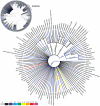A gross anatomy ontology for hymenoptera
- PMID: 21209921
- PMCID: PMC3012123
- DOI: 10.1371/journal.pone.0015991
A gross anatomy ontology for hymenoptera
Abstract
Hymenoptera is an extraordinarily diverse lineage, both in terms of species numbers and morphotypes, that includes sawflies, bees, wasps, and ants. These organisms serve critical roles as herbivores, predators, parasitoids, and pollinators, with several species functioning as models for agricultural, behavioral, and genomic research. The collective anatomical knowledge of these insects, however, has been described or referred to by labels derived from numerous, partially overlapping lexicons. The resulting corpus of information--millions of statements about hymenopteran phenotypes--remains inaccessible due to language discrepancies. The Hymenoptera Anatomy Ontology (HAO) was developed to surmount this challenge and to aid future communication related to hymenopteran anatomy. The HAO was built using newly developed interfaces within mx, a Web-based, open source software package, that enables collaborators to simultaneously contribute to an ontology. Over twenty people contributed to the development of this ontology by adding terms, genus differentia, references, images, relationships, and annotations. The database interface returns an Open Biomedical Ontology (OBO) formatted version of the ontology and includes mechanisms for extracting candidate data and for publishing a searchable ontology to the Web. The application tools are subject-agnostic and may be used by others initiating and developing ontologies. The present core HAO data constitute 2,111 concepts, 6,977 terms (labels for concepts), 3,152 relations, 4,361 sensus (links between terms, concepts, and references) and over 6,000 text and graphical annotations. The HAO is rooted with the Common Anatomy Reference Ontology (CARO), in order to facilitate interoperability with and future alignment to other anatomy ontologies, and is available through the OBO Foundry ontology repository and BioPortal. The HAO provides a foundation through which connections between genomic, evolutionary developmental biology, phylogenetic, taxonomic, and morphological research can be actualized. Inherent mechanisms for feedback and content delivery demonstrate the effectiveness of remote, collaborative ontology development and facilitate future refinement of the HAO.
Conflict of interest statement
Figures





References
-
- Honey Bee Genome Sequencing Consortium. The genome of a highly social insect, the honey bee Apis mellifera. Nature. 2006;443:931–949. - PubMed
-
- Bézier A, Annaheim M, Herbinière J, Wetterwald C, Gyapay G, et al. Polydnaviruses of braconid wasps derive from an ancestral nudivirus. Science. 2009;323:926–930. - PubMed
-
- Wheeler WM. New York: Columbia Press; 1910. Ants: Their structure, development and behaviour (Columbia Biological Series number 9).663
-
- Verhoeff C. Finden sich für die laminae basales der männlichen Coleopteren Homologa bei den Hymenopteren? Zool Anz. 1893;16:407–412.
Publication types
MeSH terms
LinkOut - more resources
Full Text Sources
Medical

